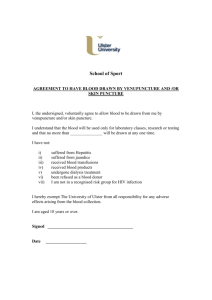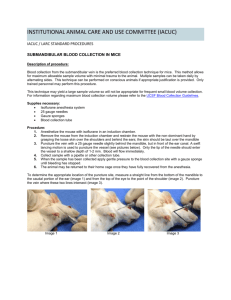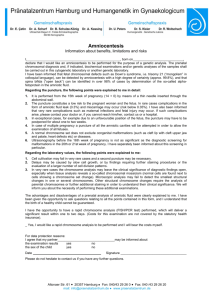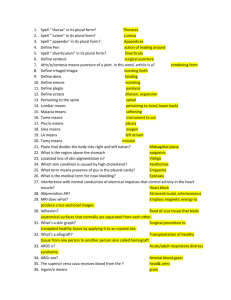P : APER PUNCTURE TESTER A NEW INSTRUMENT
advertisement
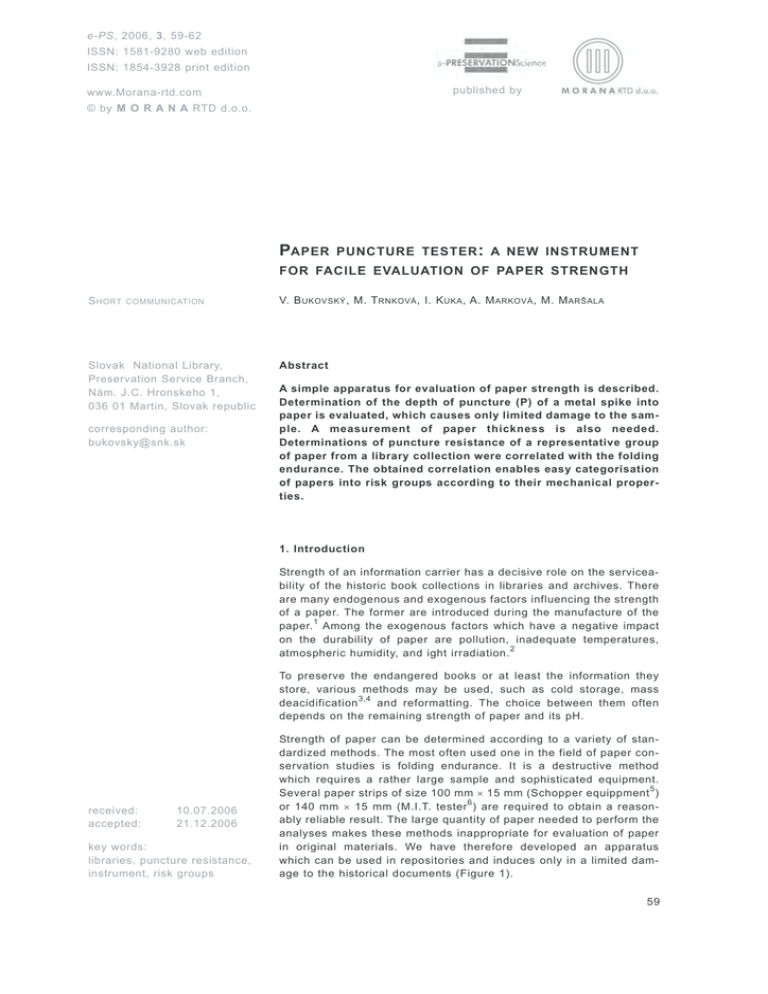
e-PS, 2006, 3, 59-62 ISSN: 1581-9280 web edition ISSN: 1854-3928 print edition published by www.Morana-rtd.com © by M O R A N A RTD d.o.o. PAPER PUNCTURE TESTER : A NEW INSTRUMENT FOR FACILE EVALUATION OF PAPER STRENGTH S HORT COMMUNICATION Slovak National Library, Preservation Service Branch, Nám. J.C. Hronskeho 1, 036 01 Martin, Slovak republic corresponding author: bukovsky@snk.sk V. B UKOVSKÝ , M. T RNKOVÁ , I. K UKA , A. M ARKOVÁ , M. M ARŠALA Abstract A simple apparatus for evaluation of paper strength is described. Determination of the depth of puncture (P) of a metal spike into paper is evaluated, which causes only limited damage to the sample. A measurement of paper thickness is also needed. Determinations of puncture resistance of a representative group of paper from a library collection were correlated with the folding endurance. The obtained correlation enables easy categorisation of papers into risk groups according to their mechanical properties. 1. Introduction Strength of an information carrier has a decisive role on the serviceability of the historic book collections in libraries and archives. There are many endogenous and exogenous factors influencing the strength of a paper. The former are introduced during the manufacture of the paper. 1 Among the exogenous factors which have a negative impact on the durability of paper are pollution, inadequate temperatures, atmospheric humidity, and ight irradiation. 2 To preserve the endangered books or at least the information they store, various methods may be used, such as cold storage, mass deacidification 3,4 and reformatting. The choice between them often depends on the remaining strength of paper and its pH. received: accepted: 10.07.2006 21.12.2006 key words: libraries, puncture resistance, instrument, risk groups Strength of paper can be determined according to a variety of standardized methods. The most often used one in the field of paper conservation studies is folding endurance. It is a destructive method which requires a rather large sample and sophisticated equipment. Several paper strips of size 100 mm × 15 mm (Schopper equippment 5 ) or 140 mm × 15 mm (M.I.T. tester 6 ) are required to obtain a reasonably reliable result. The large quantity of paper needed to perform the analyses makes these methods inappropriate for evaluation of paper in original materials. We have therefore developed an apparatus which can be used in repositories and induces only in a limited damage to the historical documents (Figure 1). 59 www.e-PRESERVATIONScience.org ® ® Figure 1: Paper puncture tester . Figure 3: The spike (type A) of the Paper puncture tester . When designing and constructing the apparatus Paper puncture tester ® (registered at Slovak Industry Ownership Office, utility model no. 4329), we were inspired by a device which is used for determination of the puncture resistance of paperboard. In this device, a well defined puncturing body, attached to a pendulum, is pressed into the material. In paperboard, the results gained from puncture resistance correlate well with another mechanical property, bursting strength. 7,8 Paper puncture tester apparatus evaluates the strength of paper in a way that a spike of a particular shape is in a measurable way punctured into the paper and, on its rounded edges, mashes (penetration parallel to the direction of paper fibres) or tears (penetration perpendicularly to the direction of paper fibres) the fibres. The character of the puncture of a spike through the paper can be seen on the opposite side from the puncture (Figure 2). Damage is limited to the furrow (or furrows in multiple use), which can be only of the size of the spike used. This damage can be easily be mended by starch and Japanese paper. The method is thus less destructive than manual folding test, during which the corner of a page is folded until it is torn off. 9 No sampling is needed, which is a major advantage over the currently used testers of mechanical properties, where a whole page from a book is often required for destructive testing. 1.2 Description of the apparatus Figure 2: The damage due to the puncture on the recto (above) and verso (below) side of the paper. On each image, the right punctures were caused when the spike was parallel to the direction of paper fibres, while the right punctures were caused by the spike, which was perpendicular to the direction The apparatus consists of 2 parts (Figure 1). Both parts are assembled and, after fastening, the analyzed paper is inserted between them. During this, the spike is secured by two rubber pressure rings, which are in each part of the device. A round opening defined by the rings is as small as possible, in order to prevent the paper from weaving during the penetration of the spike, and is limited by the size of the spike (its base). The weight of the upper part suffices to keep the paper in place during the measurement. of paper fibres. Maximum length of puncture is 19.5 mm. The longest puncture in the Figure is 11 mm long. 60 Paper Puncture Tester, e-PS, 2006, 3, 59-62 © by M O R A N A RTD d.o.o. The upper part of the apparatus serves for fixing the spike, setting up the strength, by which the spike penetrates the paper, i.e. the height from which the spike falls down. The direction of the puncture of the spike in relation to paper production can also be set, and it enables readings of the depth of penetration of the spike into paper. The spike is the most important part of the apparatus (Figure 3). Its height is 50.4 mm, base 19.5 mm while the thickness of the metal sheet is 0.6 mm. The edges of the spike are rounded into an optimal semicircle. The spike is fixed to an aluminium tube, which is 151 mm long and has an outer diameter 5.9 mm. The size of the spike is limited by the height of the lower part of the device. It is very easy to exchange the spike. The weight of the spike together with the aluminium tube and a socket defining the lifting of the spike is 16.14 g. For thicker papers it is possible to put a brass barrel of the weight 16.14 g into the tube, which doubles the weight of the spike. The depth of the puncture is then divided by two. The height from which the spike falls down can be changed by the socket on the tube. For this experiment we used the height of 50 mm. From this data we can establish that the force used was 162 mN. The setting must stop the spike even in the least firm paper and should not allow it to go through. The calibration of the apparatus is made in the way that the spike is put on a piece of thin solid material fixed between both parts of the apparatus and the gauge is set to 0. 1.3 Description of function A paper is inserted into the device. The spike is lifted up to the upper position and let down. If the depth of penetration is small (thick and heavily sized papers) and the reading is not accurate, a barrel weight (two times weight of spike) is put into the tube and the action is taken once again. The depth of the puncture is read in mm of the scale in the upper part of the apparatus. The range of the scale corresponds to the size of the lower part. If multiple measurements are performed, the distance between two punctures must be at least 15 mm. 2. Materials and methods 2.1 Paper samples 67 papers were chosen from the model library (1378 units processed in the program CDS ISIS, 1990 10 ). All papers contained groundwood (various quantities). They were produced between 1901 and 1997. Figure 4: Correlation between folding endurance and puncture resistance for paper of 0.07 mm thickness. 2.2 Air-conditioning of samples Paper samples were taken from books that were stored in an air-conditioned room (45% ± 2% relative humidity, temperature 21 ± 2 ºC). All the measurements were performed at the same ambient conditions. Ten repetitions of puncture resistance determinations in the middle of a paper sheet were done. 2.3 Measuring of folding endurance The number of double folds was determined according to Shopper test (ISO 3036). 5 Loading was 0.5 kg. The test samples were smaller than required by the standard (30 × 10 mm), as the amount of the original historic material was limited. Folding endurance is expressed as the decimal logarithm of the number of double folds. Folding endurance, as well as puncture resistance was determined in cross-machine direction. The final value was an average of ten measurements. Error was expressed is standard deviation. 3. Results and discussion 3.1 Evaluation of the results of Paper puncture tester® A linear correlation is observed between the folding endurance and puncture resistance for a number of papers with thickness 0.07 mm (Figure 4). While an average relative standard deviation of the folding endurance determinations was 40%, the average relative standard deviation associated with the puncture resistance was 10%, which indicates that the latter method provides more reproducible results. The correlation between folding endurance and puncture resistance strongly depends on the thickness of the paper. A term puncture resistance index (PRI) is thus introduced, where the puncture resistance (P) is normalised with respect to paper Paper Puncture Tester, e-PS, 2006, 3, 59-62 61 www.e-PRESERVATIONScience.org 4. Conclusion A new apparatus was developed for determination of mechanical strength of paper, which causes only limited damage to historical materials. The apparatus is simple to operate, small and portable and can be also used in repositories. Puncture resistance correlates with folding endurance and the results are more reproducible than determinations of folding endurance. The correlation between folding endurance and puncture resistance was established for a number of 19 th -century papers. Based on these results, risk categories are proposed, which allow the development of suitable preservation programmes. Figure 5: Correlation between number of double folds and puncture resistance for a variety of papers of thickness 0.07-0.16 mm. 5. Acknowledgement thickness (T), expressed in mm: PRI = -P 0.37 /log (T). The authors thank the Ministry of Education of the Slovak Republic – project 2003SP200280301KNIHA.SK-Contract 661/2003 As observed from Figure 5, a satisfactory correlation (R 2 = 0.7050) is observed when folding endurance is plotted versus puncture resistance index. The method thus enables us to obtain information about the condition of paper for a range of thicknesses included in our study (0.07 - 0.16 mm). It does not require sampling, as in the case of folding endurance measurements and is more reproducible than the latter. In addition, the instrument is portable. 3.2 Damage categories Data on the strength of a paper in a particular book are needed in order to decide for a certain preservation activity. While paper strengthening is needed to enable the use of books with very brittle paper, deacidification will prolong the useful time of acidic papers, which still retain a certain degree of flexibility. We have therefore decided to create several damage categories. More categories were created for weaker paper than in case of strong papers, which often do not need immediate attention. The 67 books, used for evaluation of the results of Paper puncture tester®, were placed in risk groups according to their folding endurance (Table 1). Name of category Folding endurance Puncture resistance index (PRI) DF-1 DF-5 DF-15 DF-80 DF > 80 1 1 < DF < 5 5< _ DF < 15 15 < _ DF < 80 DF > _ 80 3.1 > PR 3.1 > _ PR > 2.7 2.7 > _ PR > 2.5 2.5 > _ PR > 2.1 PR _ > 2.1 6. References 1. A. Blažej, M. Košík, Fytomass as a chemical raw material, Veda, Bratislava, 1985. 2. V. Bukovský, Degradation reactions of cellulose and lignin in a process of natural and accelerated ageing of paper, Slovak National Library, Martin, 2004. 3. H. J. Porck, Mass deacidification. An update of possibilities and limitations, ECPA, Amsterdam, Commission on preservation and access, Washington, 1996. 4. M. Cedzová, Deacidification and stabilization of lignocellulose information carriers, Slovak Technical University, FCHPT, Department of chemical technology of wood, cellulose and paper, Bratislava, 2004, dissertation. 5. ISO 5626 (50 0345), 1993, Pulp and paper testing. Determination of folding endurance (Schopper tester). 6. TAPPI T 511 om-06, Folding endurance of paper (MIT tester). 7. ISO 3036 (50 0351) Board, 1975, Determination of puncture resistance. 8. M. Souèek, Bursting strength, in: M. Souèek, Paper testing, SNTL, Praha, 1977, 162-165. 9. B. Zyska, Tr w a ³ o œ æ papieru w drukach polskich z lat 1800-1994. Spis treœci, Wydawnictwo Uniwersytetu Œlaºkiego, Katowice, 1999. 10. I. Kuka, Computer processing and evaluation of the state of a preserving action of the model library, in: Historic book stocks as a part of a cultural heritage, ŠVK, B. Bystrica, 1999, 95-103. 11. V. Bukovský, M. Trnková, A. Marková, M. Maršala, Influence of the amount of water in a paper on determination of the number of double folds,(work in progress). 12. V. Bukovsky and collective, Rescue, stabilization and conservation of the traditional information carriers in the Slovak Republic. (KNIHA.SK). Qualitative classification of library and archive documents, Slovak National Library, Martin, 2004. Table 1: Number of folding endurance and puncture resistance index values defining various risk groups. 62 Paper Puncture Tester, e-PS, 2006, 3, 59-62
